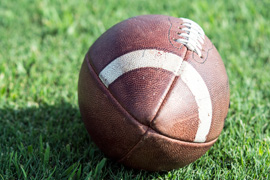October 26th, 2016
Friday Night Lights
Emily F. Moore, RN, MSN, CPNP-PC, CCRN
Most everyone has some association with football. Whether we know someone who’s played, played ourselves, or simply have nostalgic memories watching the game, football is a familiar sport to most Americans. I, for one, absolutely love football. Surprisingly, I never realized the danger involved with football until I met my husband, a high school football coach.
 Every time players suit up, they are making the conscious decision to put themselves at risk for injury. Similarly, by signing a release and allowing our children to play, we knowingly accept this risk and entrust the coach to protect and teach proper, safe technique. The severity of injuries can range from minimal to life threatening. A few weeks ago, my husband’s team endured seven injuries. A few boys sprained their ankle, one broke his collar bone, and one sustained a concussion from a hard hit. Few injuries keep players from returning to the game. The decision to return to the game is made by the coach, who largely relies on the player’s honesty. It has been documented, however, that many injuries, mainly concussions, are underreported for fear of being held from participation (Valovich McLeod et al 2007).
Every time players suit up, they are making the conscious decision to put themselves at risk for injury. Similarly, by signing a release and allowing our children to play, we knowingly accept this risk and entrust the coach to protect and teach proper, safe technique. The severity of injuries can range from minimal to life threatening. A few weeks ago, my husband’s team endured seven injuries. A few boys sprained their ankle, one broke his collar bone, and one sustained a concussion from a hard hit. Few injuries keep players from returning to the game. The decision to return to the game is made by the coach, who largely relies on the player’s honesty. It has been documented, however, that many injuries, mainly concussions, are underreported for fear of being held from participation (Valovich McLeod et al 2007).
What is the threshold we should set as parents in deciding when to keep our children from playing a particular sport? My husband regales me of stories from his childhood, when he would reenact and even “call plays” from his living room. His dream has always been to play and coach football. He even pursued a career just so he could coach high school ball. Knowing this, I ask, is it fair as parents to deprive our children of their dreams because of the risk?
It isn’t just football. According to recent statistics, soccer results in as many if not more head injuries than football (Gessel et al 2007). This is likely related to the larger number of youth (both boys and girls) who play soccer compared with football. Reportedly, the injuries sustained from soccer are generally related to players colliding into each other while simultaneously attempting to “head” the ball (Gessel). I distinctly remember, while working in the PICU, taking care of a teenager with a ruptured arteriovenous malformation from heading the soccer ball one too many times. Granted, the AVM was undiagnosed, but likely would not have ruptured without the repeated contact to the head.
As research continues to advance, more attention is placed on the danger of traumatic brain injury at a young age. We know that children ages 5-18 are much more vulnerable to head injuries than their adult counterparts. It is estimated that 30-45 million children participate in competitive sports. Additionally, there are approximately 200,000 head injuries seen in the emergency department each year (Gioia et al 2009). Traumatic brain injury is the leading case of hospitalization and death among children and adolescents and therefore represents a major public health problem (Langlois et al 2006). I ask myself, if enough parents decide they do not want their child to play any sport, whether it be football, soccer, hockey, or basketball, will that sport then shift to the margins? In other words, will risk outweigh the benefit and result in team sports slowly fading out of society? As we see more attention shifted to concussions and protection, one may question the future of competitive sports.
 As providers, it is our responsibility to provide appropriate anticipatory guidance to parents and players prior to signing a sports clearance. Prevention of injury focuses on education, not only to the athletic community but to the parents. So, are we doing enough, or should we be doing more? Is it our job to sit with each parent prior to signing a sports clearance and state the pros and cons of each sport? Do we explain what a brain injury looks like, what to remember when your child gets hit, and lastly, when to seek medical attention? Or do we assume that the current knowledge among coaches and parents within the athletic community is enough without the addition of the primary care provider’s input?
As providers, it is our responsibility to provide appropriate anticipatory guidance to parents and players prior to signing a sports clearance. Prevention of injury focuses on education, not only to the athletic community but to the parents. So, are we doing enough, or should we be doing more? Is it our job to sit with each parent prior to signing a sports clearance and state the pros and cons of each sport? Do we explain what a brain injury looks like, what to remember when your child gets hit, and lastly, when to seek medical attention? Or do we assume that the current knowledge among coaches and parents within the athletic community is enough without the addition of the primary care provider’s input?
On the other hand, there are many pros to competitive group sports. We are teaching our children how to be competitive but learn to lose at the same time — an invaluable life skill. We show our children how to help out their teammates and encourage those who are down. It teaches them how to work together as a team, with the common goal of winning. As a coach’s wife, I hear about the struggles and strengths of individual team members and have watched many football players overcome their struggles. I have also witnessed teammates encourage and build each other up during a game or in practice.
So, I ask my colleagues, is the benefit of sportsmanship worth the risk of a potentially life-changing injury? Or is that risk small enough that we can continue to look on and encourage the multitude of paybacks gained from team sports?
I personally feel that the life skills learned from competitive group sports are irreplaceable. However, the growing research regarding head injuries is concerning. Therefore, as a clinician I am torn. Moving forward, I will provide the proper counseling to my patients so I know that their decision to play or not was informed.
References:
Gessel, L. M., Fields, J.D., Collins, C. L., et al (2007). Concussions among United States high school and collegiate athletes. Journal of Athletic Training, 42(4), 495-503
Gioia, G. A., Schneider, J.C., Vaughan, C. G., et al (2009). Which symptom assessments and approaches are uniquely appropriate for paediatric concussion? British Journal of Sports Medicine, 43(suppl 1), i12-i22.
Langlois, J.A., Rutland-Brown, W., & Thomas, K.E. (2006). Traumatic Brain Injury in the Unites Sates: Emergency department visits, hospitalizations and deaths. Atlanta, GA: Centers for Disease Control and Prevention, National Center for Injury Prevention and Control.
Valovich McLeod, T.C., Schwartz, C., & Bay, R. C. (2007). Sports-related concussions misunderstanding among youth coaches, Clinical Journal of Sports Medicine, 2007(17), 140-141.



Does “sport” have to involve “danger”? Admittedly there is nothing without risk, but how about the risk reward equation. How about harm reduction – no smashing brains into the hockey boards, no (be)headings, and no unmitigated head blows (sport is the only place on the planet where the laws of assault are suspended).
P.S. My Canadian son stopped hockey once the violence started, and continues to be physically fit and sports active – as well as engaging in higher education. There is a way through this – but who wants to set the path (other than the already damaged – for whom it is too late)?
Max-
Thank you for your response. I agree, we should find a way for our children to play sports and be athletic without allowing the violent nature of competition to take over.
Emily
I appreciate the conundrum faced – as both a parent and a provider. I’m curious, though, as to why more recent literature was not included as the basis for this piece? In the past ten years since the references were published, there have been numerous high-quality reports made available.
S Brown,
I should have used more updated literature, as you are correct, there are more recent reports published.
Thank you,
Emily